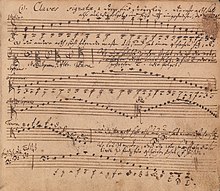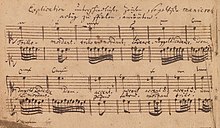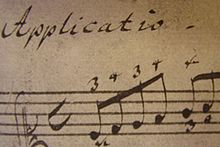Piano booklet for Wilhelm Friedemann Bach
The piano booklet for Wilhelm Friedemann Bach is a collection of smaller compositions, mainly by Johann Sebastian Bach . Bach wrote the notebook for his eldest son Wilhelm Friedemann Bach ; the original title is Clavier-Büchlein before Wilhelm Friedemann Bach . Today the shorter and modernized title Piano Booklet for Wilhelm Friedemann is often used. On the title page, Bach noted January 22, 1720 as the beginning of the collection.
The works were written for the keyboard instruments that were common and popular at the time , i.e. for clavichord and harpsichord (or spinet ). Most of the pieces included are early versions of the Well-Tempered Clavier and Inventions and Symphonies collections, which were later compiled . There are also numerous individual sentences.
Two years later, Bach created a very similar booklet for his wife Anna Magdalena, the Notebook for Anna Magdalena Bach , which was followed by a second a few years later . Corresponding collections have not been preserved for his other children and his numerous students.
background
Half of all entries (source A) in the Clavierbüchlein before Wilhelm Friedemann Bach come from JS Bach himself and the other half from his son Wilhelm Friedemann, who is ten years old in 1720. Two other unknown scribes appear temporarily. In the critical report of the New Bach Edition for Clavierbüchlein portrays Wolfgang Plath the history of the manuscript:
For the “early history” of the manuscript, we rely on guesswork. Wilhelm Friedemann may have taken the manuscript with him as personal property when he moved out of his parents' house in 1733. During his time in Halle , between 1746 and 1770, the little book must have come into the possession of his distant relative (and probably also a pupil) Johann Christian Bach , the so-called “Halle Piano Bach”, who later worked at the pedagogy in Halle and was evidently an excellent musician. The next owner is Johann Nicolaus Kötschau , music director in Schulpforta. He purchases the piano book "along with many Bach and other musical items [...] from the B. [Achish] family" in 1814 from the estate of J. Chr. Bach. The piano booklet is mentioned under No. 691 in the printed Kötschau estate directory: “Sebastian Bach, Clavierbüchlein, written by Sebastian Bach himself in 1720”. The lawyer and composer Gustav Krug bought it from the auction; one of his grandchildren, the music writer Siegfried Krug, finally sold it in the spring of 1932 to the Library of the School of Music, Yale University, New Haven, Connecticut (USA) via the Munich antiquarian Flinkstaedt.
The numerous other sources contain individual pieces or sections of the clavier booklet . Copies or early prints are also used to supplement the content, as it is unclear whether the fragmentary shape of many pieces is due to chance or to the fact that pages are lost.
Authorship
Most of the compositions are by Johann Sebastian Bach, but the music book also contains three suites by other composers. They include JC Richter , GP Telemann and Gottfried Heinrich Stöltzel , as well as Wilhelm Friedemann Bach himself.
The sentences that the editors of the Bach Works Directory were able to associate most closely with Johann Sebastian were summarized there under the title Nine Small Preludes (BWV 924 to 932); some researchers ascribe them to Wilhelm Friedemann.
content
Overview
The book begins with a preface explaining the notation : First, be Clef explained ( "claves signatae", see picture above), then the resolution of ornaments ( "explication of different characters, certain manners to play like that suggest", see picture right).
On the whole, the pieces are obviously arranged in a didactically sensible order. At the beginning, the Applicatio in C major (BWV 994) and the Prelude in G minor (BWV 930) are particularly noticeable because they are the only surviving examples of Bach's autograph fingerings . (Bach's only other work with preserved fingerings is the C major prelude BWV 870a, but there they were not written by himself, but possibly by Johann Caspar Vogler (1696–1765), Bach's student and successor in office in Weimar .)
This is followed by a few easy individual movements - preludes, dances and chorale arrangements - and then eleven preludes, which were later to become part of the Well-Tempered Clavier in a revised form . After a few more individual movements and sketches, the two-part inventions follow in early versions, then two suites by other composers and finally the three-part inventions . Bach arranged the inventions here in the order of an ascending and descending scale, the preludes of the later Well-Tempered Clavier as a ladder ascending twice to a fourth.
List of pieces of music in the sequence of the manuscript
13 individual sentences:
- 1. Applicatio C major (BWV 994): Sixteen-bar prelude-like composition of scales and chords, with fingerings
- 2. Preamble in C major (BWV 924, Nine Little Preludes No. 1)
- 3. Who only lets God rule (Choral Prelude for Organ , BWV 691a)
- 4. Prelude in D minor (BWV 926, Nine Little Preludes No. 3)
- 5. Jesus, my joy (Choral Prelude for Organ, BWV 753. Incomplete)
- 6. Allemande in G minor (BWV 836. Possibly by Wilhelm Friedemann Bach)
- 7. Allemande in G minor (BWV 837th fragment, possibly by Wilhelm Friedemann Bach)
- 8. Preamble in F major (BWV 927, Nine Little Preludes No. 4)
- 9. Preamble in G minor (BWV 930, Nine Little Preludes No. 7)
- 10. Prelude in F major (BWV 928, Nine Little Preludes No. 5)
- 11. Minuet 1 in G major (BWV 841, another manuscript, possibly not by Johann Sebastian Bach; also contained in the sheet music for Anna Magdalena Bach from 1722)
- 12.Muet 2 in G minor (BWV 842, foreign handwriting)
- 13. Minuet 3 G major (BWV 843)
Preludes from the Well-Tempered Clavier , Volume 1:
- 14. Prelude in C major (BWV 846a, early version)
- 15. Prelude in C minor (BWV 847)
- 16. Prelude in D minor (BWV 851)
- 17. Prelude in D major (BWV 850)
- 18. Prelude in E minor (BWV 855a, early version)
- 19. Prelude in E major (BWV 854)
- 20. Prelude in F major (BWV 856)
- 21. Prelude in C sharp major (BWV 848)
- 22. Prelude in C sharp minor (BWV 849)
- 23. Prelude in E flat minor (BWV 853)
- 24. Prelude in F minor (BWV 857)
Suite:
- 25. Piéce pour le Clavecin, composed by JC Richter . - Suite for harpsichord by Johann Christoph Richter , consists only of an allemande and an incomplete courante .
Little preludes:
- 26. Prelude in C major (BWV 924a, early version of the first of the Nine Little Preludes )
- 27. Prelude in D major (BWV 925, Nine Little Preludes 2)
- 28. Prelude in E minor (BWV 932, Nine Little Preludes 9)
- 29. Prelude in A minor (BWV 931, Nine Little Preludes 8)
Sketch:
- 30. Ten bars of an untitled bass part in G minor (without numbering; not included in the Bach works index)
Gap:
- 31. Fugue a 3 in C major (BWV 953)
Two-part inventions:
- 32. Preamble 1 in C major (BWV 772, Invention 1)
- 33. Preamble 2 in D minor (BWV 775, Invention 4)
- 34. Preamble 3 in E minor (BWV 778, Invention 7)
- 35. Preamble 4 in F major (BWV 779, Invention 8)
- 36. Preamble 5 in G major (BWV 781, Invention 10)
- 37. Preamble 6 in A minor (BWV 784, Invention 13)
- 38. Preamble 7 in B minor (BWV 786, Invention 15)
- 39. Preamble 8 in B flat major (BWV 785, Invention 14)
- 40. Preamble 9 in A major (BWV 783, Invention 12)
- 41. Preamble 10 in G minor (BWV 782, Invention 11)
- 42. Preamble 11 in F minor (BWV 780, Invention 9)
- 43. Preamble 12 in E major (BWV 777, Invention 6)
- 44. Preamble 13 in E flat major (BWV 776, Invention 5)
- 45. Preamble 14 in D major (BWV 774, Invention 3)
- 46. Preamble 15 in C minor (BWV 773, Invention 2)
Two suites:
- 47th Suite in A major by Georg Philipp Telemann . Three movements: Allemande, Courante and Gigue (BWV 824)
- 48. Partia di Signore Steltzeln , harpsichord suite in G minor by Gottfried Heinrich Stölzel . Four movements: Ouverture , Air Italy, Bourrée , Minuet . Bach added a trio to the minuet (BWV 929, where it is performed as Nine Little Preludes 6); it is also found in a copy in the 3rd French Suite.
Three-part symphonies:
- 49. Fantasia 1 in C major (BWV 787, Sinfonia 1)
- 50th Fantasia 2 in D minor (BWV 790, Sinfonia 4)
- 51. Fantasia 3 in E minor (BWV 793, Sinfonia 7)
- 52nd Fantasia 4 in F major (BWV 794, Sinfonia 8)
- 53rd Fantasia 5 in G major (BWV 796, Sinfonia 10)
- 54. Fantasia 6 in A minor (BWV 799, Sinfonia 13)
- 55th Fantasia 7 B minor (BWV 801, Sinfonia 15)
- 56. Fantasia 8 in B flat major (BWV 800, Sinfonia 14)
- 57. Fantasia 9 in A major (BWV 798, Sinfonia 12)
- 58. Fantasia 10 in G minor (BWV 797, Sinfonia 11)
- 59. Fantasia 11 in F minor (BWV 795, Sinfonia 9)
- 60th Fantasia 12 in E major (BWV 792, Sinfonia 7)
- 61. Fantasia 13 in E flat major (BWV 791, Sinfonia 5)
- 62. Fantasia 14 in D major (BWV 789, Sinfonia 3)
- 63. Fantasia 15 in C minor (BWV 788, Sinfonia 2)
Purpose of the piano booklet
In the critical report on the piano book for Wilhelm Friedemann Bach, Wolfgang Plath brings several arguments that question the purpose of the piano book as a piano school. The pieces are too difficult for a piano beginner (cf. No. 1), and Wilhelm Friedemann was able to play the piano even before the booklet was created. Plath also does not see the claves signatae or the explication of different signs in a piano pedagogical context, but rather these "first kat'exoch didactic entries" JS Bach may have made, so to speak, 'pro memoria', probably also to illustrate the dry table of manners. "From the Allemande No. 6 is Wilhelm Friedemann's first exercise in composition, which is to be followed by others (cf. No. 26 and No. 2). In conclusion, Plath sums up:
“Without any doubt, it can now finally be explained why the 'small forms', i.e. preludes (preambula) and dance movements, dominate in the little piano book, why suite-like structures (one in an artfully veiled, another in an undisguised variation style) are introduced so late - and why the only fugue that the little piano book knows is also the last entry by JS Bach's hand: the composition course (not the piano lesson !) Gradually progresses from the simple to the complicated, persists in the effort of the three-part fantasies and follows the point where the fine art of the fugue comes into the focus of the student. It is no coincidence that the piano book for Wilhelm Friedemann Bach comes to an end at this level. "
Web links
- Piano booklet for Wilhelm Friedemann Bach : Sheet music and audio files in the International Music Score Library Project
- Piano booklet for Wilhelm Friedemann Bach: Source A in the beincke Rare Book & Manuscript Library of the Yale University Library.
swell
- ^ Wolfgang Plath: Little piano book for Wilhelm Friedemann. Critical report . In: Johann Sebastian Bach Institute Göttingen and Bach Archive Leipzig (ed.): Johann Sebastian Bach. New edition of all works (NBA) . tape V , no. 5 . Bärenreiter, Kassel / Leipzig 1963, p. 63 f .
- ↑ Quentin Faulkner: JS Bach's Keyboard Technique: A Historical Introduction . Concordia Publishing House, St. Louis 1984.
- ^ Christoph Wolff : Johann Sebastian Bach . 2nd edition 2007. S. Fischer, Frankfurt am Main, ISBN 978-3-596-16739-5 , page 246.
- ^ Wolfgang Plath: Little piano book for Wilhelm Friedemann Bach. Critical report . S. 70 .
- ^ Wolfgang Plath: Little piano book for Wilhelm Friedemann Bach. Critical report . S. 70 f .


